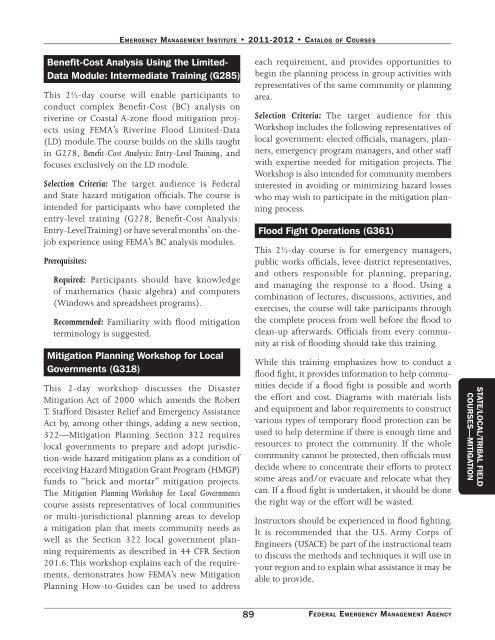EMI Course Catalog - Emergency Management Institute - Federal ...
EMI Course Catalog - Emergency Management Institute - Federal ...
EMI Course Catalog - Emergency Management Institute - Federal ...
Create successful ePaper yourself
Turn your PDF publications into a flip-book with our unique Google optimized e-Paper software.
EmErgEncy managEmEnt InstItutE • 2011-2012 • catalog of coursEs<br />
Benefit-Cost Analysis Using the Limited-<br />
Data Module: Intermediate Training (G285)<br />
This 2½-day course will enable participants to<br />
conduct complex Benefit-Cost (BC) analysis on<br />
riverine or Coastal A-zone flood mitigation projects<br />
using FEMA’s Riverine Flood Limited-Data<br />
(LD) module. The course builds on the skills taught<br />
in G278, Benefit-Cost Analysis: Entry-Level Training, and<br />
focuses exclusively on the LD module.<br />
Selection Criteria: The target audience is <strong>Federal</strong><br />
and State hazard mitigation officials. The course is<br />
intended for participants who have completed the<br />
entry-level training (G278, Benefit-Cost Analysis:<br />
Entry-Level Training) or have several months’ on-thejob<br />
experience using FEMA’s BC analysis modules.<br />
Prerequisites:<br />
Required: Participants should have knowledge<br />
of mathematics (basic algebra) and computers<br />
(Windows and spreadsheet programs).<br />
Recommended: Familiarity with flood mitigation<br />
terminology is suggested.<br />
Mitigation Planning Workshop for Local<br />
Governments (G318)<br />
This 2-day workshop discusses the Disaster<br />
Mitigation Act of 2000 which amends the Robert<br />
T. Stafford Disaster Relief and <strong>Emergency</strong> Assistance<br />
Act by, among other things, adding a new section,<br />
322—Mitigation Planning. Section 322 requires<br />
local governments to prepare and adopt jurisdiction-wide<br />
hazard mitigation plans as a condition of<br />
receiving Hazard Mitigation Grant Program (HMGP)<br />
funds to “brick and mortar” mitigation projects.<br />
The Mitigation Planning Workshop for Local Governments<br />
course assists representatives of local communities<br />
or multi-jurisdictional planning areas to develop<br />
a mitigation plan that meets community needs as<br />
well as the Section 322 local government planning<br />
requirements as described in 44 CFR Section<br />
201.6. This workshop explains each of the requirements,<br />
demonstrates how FEMA’s new Mitigation<br />
Planning How-to-Guides can be used to address<br />
89<br />
each requirement, and provides opportunities to<br />
begin the planning process in group activities with<br />
representatives of the same community or planning<br />
area.<br />
Selection Criteria: The target audience for this<br />
Workshop includes the following representatives of<br />
local government: elected officials, managers, planners,<br />
emergency program managers, and other staff<br />
with expertise needed for mitigation projects. The<br />
Workshop is also intended for community members<br />
interested in avoiding or minimizing hazard losses<br />
who may wish to participate in the mitigation planning<br />
process.<br />
Flood Fight Operations (G361)<br />
This 2½-day course is for emergency managers,<br />
public works officials, levee district representatives,<br />
and others responsible for planning, preparing,<br />
and managing the response to a flood. Using a<br />
combination of lectures, discussions, activities, and<br />
exercises, the course will take participants through<br />
the complete process from well before the flood to<br />
clean-up afterwards. Officials from every community<br />
at risk of flooding should take this training.<br />
While this training emphasizes how to conduct a<br />
flood fight, it provides information to help communities<br />
decide if a flood fight is possible and worth<br />
the effort and cost. Diagrams with materials lists<br />
and equipment and labor requirements to construct<br />
various types of temporary flood protection can be<br />
used to help determine if there is enough time and<br />
resources to protect the community. If the whole<br />
community cannot be protected, then officials must<br />
decide where to concentrate their efforts to protect<br />
some areas and/or evacuate and relocate what they<br />
can. If a flood fight is undertaken, it should be done<br />
the right way or the effort will be wasted.<br />
Instructors should be experienced in flood fighting.<br />
It is recommended that the U.S. Army Corps of<br />
Engineers (USACE) be part of the instructional team<br />
to discuss the methods and techniques it will use in<br />
your region and to explain what assistance it may be<br />
able to provide.<br />
FEdErAL EmErgENCy mANAgEmENT AgENCy<br />
STATE/LOCAL/TRIBAL FIELD<br />
COURSES—MITIGATION

















